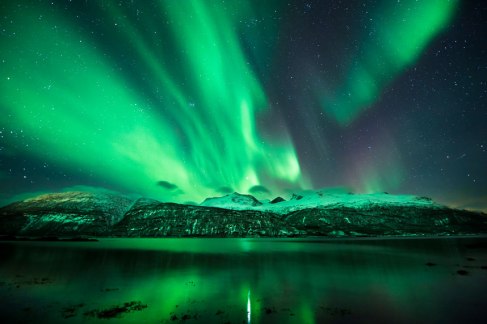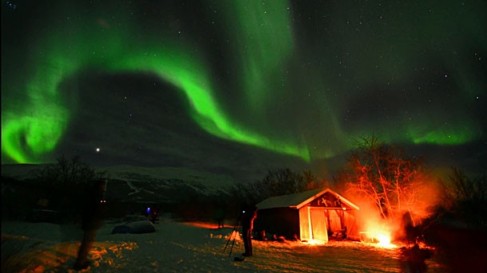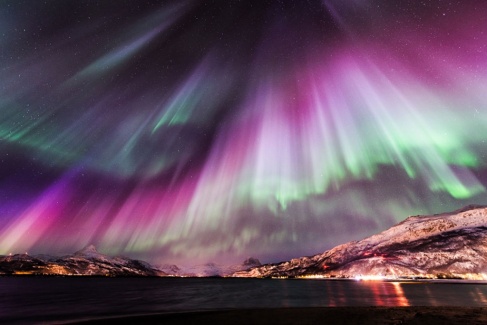The northern lights, also known as aurora borealis, are a naturally occurring phenomena that occur in parts of Scandinavia (Norway, Sweden, Iceland, Finland) and countries like Canada and Greenland that lie within the Arctic Circle. If you love the outdoors, this is definitely something you should see. Since 2013 is a peak yearin the 11-year cycle of auroral activity here is a guide to everything you need to know about where, when and how to watch this breathtaking spectacle.
What are the northern lights?
Picture the sky glowing yellowish-green, purplish-blue or pale pink for miles. The northern lights are a naturally occurring phenomena caused by charged particles thrown by the sun, which collide with gases in the Earth’s atmosphere. Depending on your luck, you might see anything from waving ribbons to rippling curtains or even shooting waves of light. The spectacle can last anywhere from a few minutes to a few hours.
When to go?
The northern lights are best viewed on dark and cloudless winter nights. Aurora season lasts all of winter—right from September through March. They are usually spotted between 8pm and 4am so count on being awake all night. They can take place as often as every day or every other day; so don’t be disheartened if you do not see one straight off; the longer you spend in the area, the more likely you are to see one. Keep in mind that seeing an aurora is not guaranteed, though you can increase your chances with a few apps like Aurora Forecast by TINAC for Apple and Aurora Buddy for Android users.
Where to go?
The northern lights occur over the earth’s magnetic poles. To get the clearest views head to the northern parts of Nordic countries like Norway, Finland and Sweden or the southern tips of Iceland and Greenland. They are also prominently visible in Alaska and Canada and occasionally in Russia and Scotland too. Save yourself a lot of planning by signing up for one of many already available tours, or if you are not inclined toward a tour you can easily plan your own itinerary. It’s a good idea to sign up for other activities like sledding and snowmobiling or even touring the surrounding area, so that you have things to do if the lights do not appear.
Make it happen:
The Great Canadian Adventure Company (www.adventures.ca) offers four and five-night packages from Rs35,000 per person, which includes accommodation, hearty local fare, excursions to see the northern lights and perks like soaking in luxurious hot tubs while you wait for the lights to appear.
If you want to experience something truly extraordinary, visit Sweden’s ICEHOTEL (www.icehotel.com), a unique structure constructed every winter entirely out of ice, only to completely melt in summer and be rebuilt again in winter (opening mid-December). They have a sauna and spa that will keep you rejuvenated when you are not out and about in the cold. If you enjoy photography, check out the Autumn Northern Lights Adventure by The Aurora Zone (www.theaurorazone.com) which hosts a four-day tour in Sweden which includes dog sledding to see the auroras, and having experts teach you the best way to capture the phenomenon on film.
For a dose of adventure, take a look at All Iceland’s Northern Lights Extreme Adventure Tour(www.alliceland.com), which includes bathing in geothermal pools under the stars, snow scooter rides on glaciers and visits to Mt Hekla (an active volcano) as well as the Great Geysir. Norway is another option, from where you can board a Hurtigruten cruise ship (www.hurtigruten.com) which offers spectacular views of the surrounding glaciers and fjords in addition to a front seat view to the auroras. They offer an 11-day cruise along the entire Norwegian coastline for Rs2,38,000 per person; or you can choose to hop on and off at any of their daily stops.
What to take?
Considering that temperatures are below freezing, being at the poles can be dangerous if you are not well prepared. Usually, organized tours provide appropriate gear like heavy outer garments, but there are still things you will need to avoid the very real threat of frostbite. Carry thermal inners, enough woollen and fleece layers to keep you warm and outerwear that is insulated as well as waterproof. For your feet, you will need woollen socks and sturdy boots with a good grip. Headgear is crucial: fleece hats and face masks are good options. Carrying sunglasses or goggles is important, as snow gives off a fiercely blinding glare. Finally, moisturiser and lip balm will be your two best friends on this trip, protecting your skin and reducing the extent of dryness and chapping.
Do I require a visa?
Indian nationals require a Schengen visa to visit Iceland, Norway, Finland and Sweden.(www.schengenvisitorvisa.com). If you choose to go to USA, Canada or Greenland, Indians have to apply to their individual consulates for a tourist visa. USA (www.ustraveldocs.com), Canada (www.vfs-canada.co.in) andGreenland (http://greenland.visahq.in)


